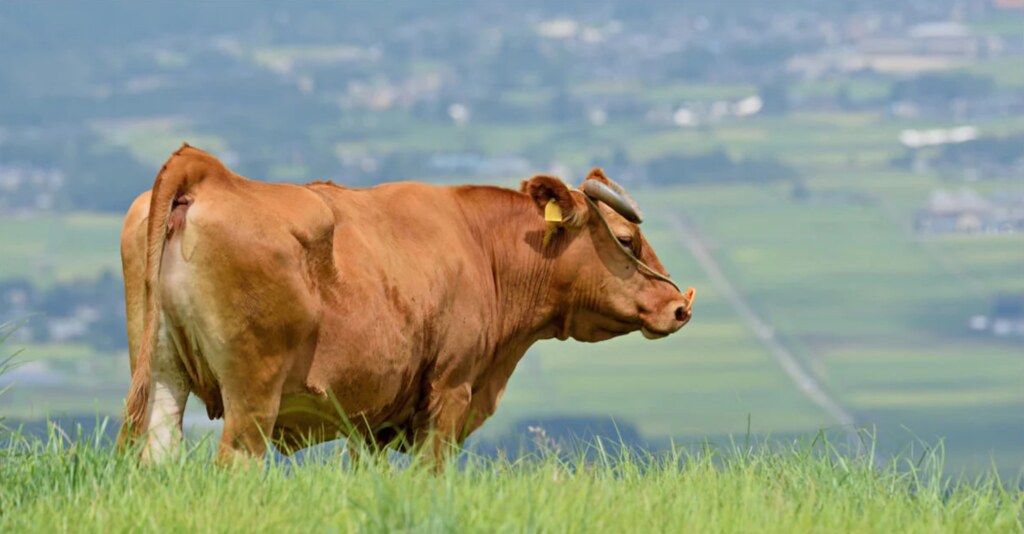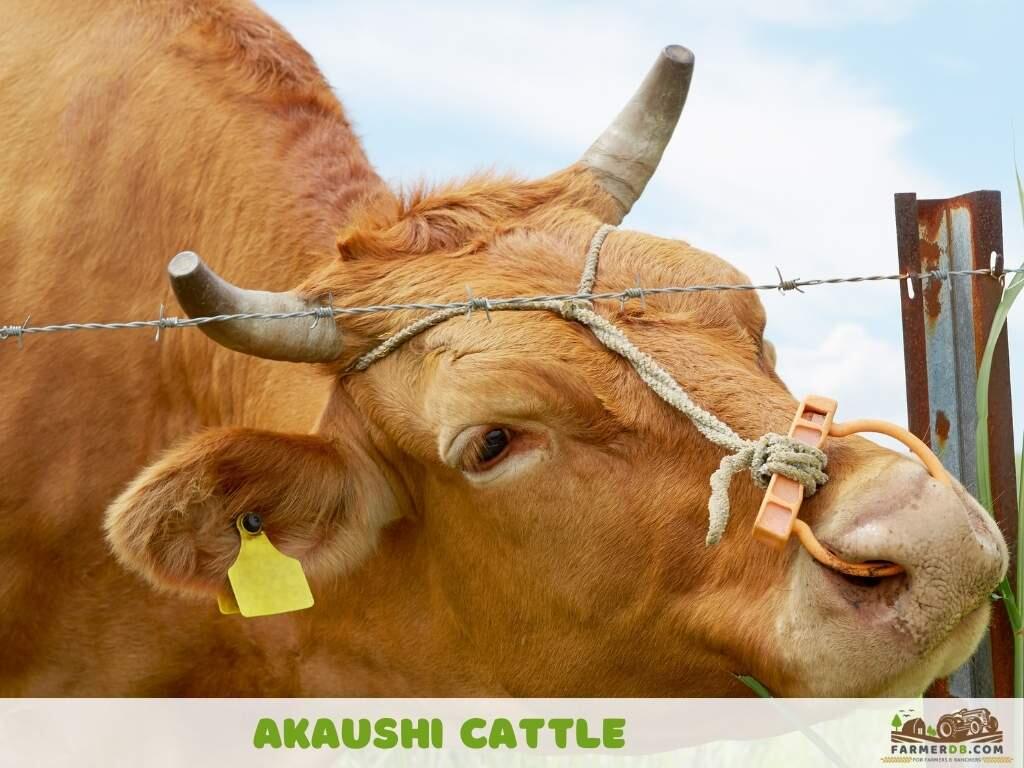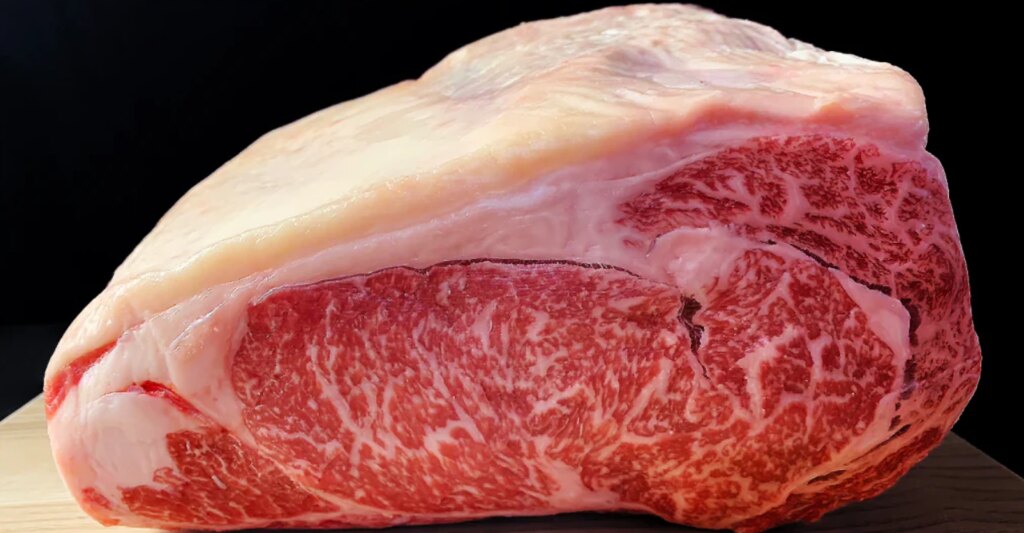Akaushi cattle, also called Akage Washu, Japanese Brown, or Japanese Red, are a type of domestic beef cattle and one of the four Wagyu breeds.
For more than 100 years, this breed has been carefully improved while keeping all of its original qualities. No important traits were lost during this process.

This improvement was possible because of a special breed association that collected detailed information about each cow. Also, before new Akaushi cattle were used for production, they went through careful statistical analysis to make sure they met high standards.
The Akaushi breed comes from a mix of Simmental cattle, British Devon, and Korean Hanwoo, which gives them their special characteristics.
These cattle are mostly raised in Japan but also in the United States, where they were first brought in 1994.
In the U.S., where it is known as American Akaushi, the breed has been further developed, improving its carcass performance.
Contents
Characteristics
Color
These cattle have a reddish-brown color, which is why they are also called red or brown cattle. Their color is not solid but varies from light brown to deep red.
Coat
They have a slick coat. In colder regions, they develop a thicker coat for insulation but shed it as temperatures rise.
Head
They have a medium-sized head with two medium-sized eyes positioned slightly forward. The forehead is broad, and the muzzle is well-defined.
The ears are of average size, slightly rounded at the tips. Their nose is usually light pink or pale brown, matching their reddish-brown coat.

Horns
Akaushi are horned cattle.
The horns are short, curved, and light in color, usually cream or pale yellow, with darker tips.
For easier management, they are often dehorned.
Body and Legs
Their body is muscular and well-built. They have a strong, straight back, a deep chest, and a smooth underline.
The legs, like the body, are hardy, muscular, and have good structure and alignment.
Size
The size of these cattle varies depending on the region where they are raised and the breeding practices used.
In Japan, they are mostly small, with some classified as small to medium-sized. In America, they have a larger frame and are classified as a medium-sized breed.
In the Wagyu cattle world, it is well known that Akaushi with bloodlines from Tamamaru are considered cattle with a moderate frame.
Lifespan
Cattle from this breed can live up to 20 years, which is slightly longer than Simmental cattle.
Their productive life is also longer, as cows can reproduce even at 15 years old, and bulls can be used for breeding until they are 10 to 11 years old.
Their long lifespan makes them a reliable choice for breeding and herd sustainability.
Growth Rate
How fast do they grow?
This breed has a moderate growth rate.
Compared to Japanese Black, Akaushi grows much faster and develops more pronounced marbling at a younger age. The growth difference between the two is 60 to 70 lbs (27 to 32 kg) at 6 to 8 months, and it can increase up to 250 lbs (113 kg) by 12 months.
Breeders often compare the daily average gain of this cattle with Angus, as they are considered to have similar growth rates.
The average daily gain for this breed is 1.70 to 2.10 lbs (0.77 to 0.95 kg) in grass-fed conditions and 2.90 to 3.25 lbs (1.32 to 1.47 kg) in a feedlot setting.
Weight
A mature female can weigh around 1,200 pounds (544 kg), while bulls have an average weight of 1,700 pounds (770 kg). At birth, calves typically weigh between 65 and 70 pounds (29 to 32 kg).
Slaughtered Time
The ideal slaughter age for these cattle is around 18 to 24 months.
At 18 to 20 months, F1 Akaushi heifers usually weigh 882-1000 lbs (400-454 kg), while bulls range from 1,250-1,450 lbs. (567-658 kg). By 24 months, they can reach up to 1,550 lbs. (703 kg).
These numbers are just averages, as final weight depends on genetics and farm management.
Some farmers grain-finish them for 180 days before they turn 18 months old, then slaughter them at 18 months. Others prefer to wait until 24 months, allowing the meat to develop more marbling than it would at 18 months.
It’s also common to raise them similar to Japanese Black cattle, feeding them at a slower rate and slaughtering them at 28 to 30 months for even more marbling.
Temperament
This breed has a mild temperament and is docile and easy to handle. They get along well with people and other animals and do not show aggression, nervousness, or overreact to their surroundings.
They remain calm and are less likely to panic or become stressed. Their calm nature is great, as it prevents them from making sudden movements or jumps that could lead to injuries.
Meat

There’s a common misconception that Akaushi beef is lean and lacks marbling, but that’s not true. This idea usually comes from comparing it to Japanese Black Wagyu, which has an extremely high fat content.
Akaushi beef still has plenty of marbling, but the fat is more evenly distributed throughout the muscle, rather than forming thick streaks. This gives it a rich, buttery flavor with a balanced fat-to-meat ratio.
Fact: The marbling it has helps it reach high USDA Prime and Choice grades at a younger age.
The texture is meatier and requires more chewing, yet it remains far superior to standard commercial beef in tenderness and quality.
Beyond taste, this beef comes with real nutritional benefits. It has a higher ratio of monounsaturated fats (MUFAs) to saturated fats (SFAs) than most other beef, making it a healthier option. It’s also high in oleic acid, the same heart-healthy fat found in olive oil. This helps reduce LDL (bad) cholesterol, lower systolic blood pressure, and support heart health.
Another important component is conjugated linoleic acid (CLA), which has been linked to a stronger immune system, a lower risk of heart disease, and better blood sugar regulation.
Raising
Feeding
Akaushi cattle can develop well on both grass-fed and grain-fed diets. No matter the feeding system, they tend to develop more marbling than commercial beef cattle.
One thing to keep in mind when feeding Akaushi cattle is their very good feed conversion compared to other breeds. If you have other cattle breeds on your farm, you’ll notice that Akaushi cattle eat less but gain more weight. On average, they can gain 1 lbs (0.45 kg) for every 4 to 5 lbs (1.81 to 2.27 kg) of feed consumed.
Grass-Fed Diet
When raising them on a grass-fed diet, you can include the following:
- Fresh pasture grasses – Prepare your pasture with ryegrass, fescue, bermudagrass, or alfalfa for optimal grazing.
- Legumes – Adding clover, alfalfa, or vetch is an easy way to increase protein in their diet.
- Hay and silage – These are great options during seasons when grass availability is low. Make sure to use high-quality hay to maintain their nutrition.
Grain-Fed Diet
In a grain-fed system, you can offer everything from the grass-fed diet while adding:
- Grains – Sorghum, corn, barley, and wheat to boost energy intake.
- Protein sources – Cottonseed meal or soybean meal for muscle development.
- Fat sources (in moderation) – Flaxseed, tallow, or canola meal to improve intramuscular fat and marbling.
In both feeding methods, it’s important to supplement with vitamins and minerals to ensure balanced nutrition.
Always provide a constant supply of fresh, clean water, as hydration is essential for their health and growth.
Environment and Climate
These cattle do well in various environments, including pasture-based systems as well as more intensive farming operations.
Just like with different environments, they can also live in a wide range of climates. They tolerate both cold and hot conditions, including extreme climates like those in Australia and South Africa, especially when they are properly acclimated before experiencing peak temperatures.
Acclimatization takes around 30 to 40 days, no matter where they are relocated.
Shelter
Yes, these cattle need shelter as their health can be affected by extreme weather conditions, which may also cause stress that impacts meat quality.
A well-built shelter provides comfort and protection during harsh winds, freezing temperatures, and heavy snowfall, as well as high temperatures. In hot climates, you can also create natural shelters using trees, hills, or open barns to help them stay cool.
How many cattle per acre?
You need 3.5 to 5 acres of land to raise one Akaushi cattle with lush grass, and up to 7-8 acres if vegetation is sparse.
The number of acres needed can vary depending on whether you supplement their feed with grains or use rotational grazing practices.
Breeding
Akaushi cattle reach puberty at around 12 to 14 months of age.
Breeding Methods
There are several breeding options for Akaushi cattle, including natural breeding, artificial insemination (AI), and embryo transfer (ET).
In the United States, the most common method for this breed is artificial insemination (AI). Many cattle breeding programs offer access to top-quality genetics, allowing breeders to purchase or collect semen and inseminate cows at the optimal time for conception.
Fertility and Crossbreeding
Akaushi cows and bulls have high fertility rates, increasing the chances of successful conception on the first insemination.
Bulls are known for their hybrid vigor and are frequently used in crossbreeding programs to improve other cattle breeds. Their genetics contribute to better marbling, improved feed efficiency, and stronger overall performance in crossbred offspring.
To preserve breed integrity, full-blood Akaushi cattle must be DNA-verified by the American Akaushi Association (AAA). AAA guidelines require DNA testing for AI sires and ET donor dams before any registration assessments are completed.
Maternal Traits and Calving
Akaushi cows remain productive for many years, producing healthy calves with good birth weights and high survival rates.
- They have easy calving, rarely requiring assistance.
- Their strong maternal instincts allow them to raise calves without intervention.
Milk Production
One downside of Akaushi cows is their lower milk production compared to some other breeds. However, their milk supply is still sufficient to nourish the calves until weaning.
Their tight udders and well-sized teats are an advantage, as they do not interfere with feeding and help prevent udder-related health issues.
Terminal vs. Maternal
These cattle are considered both terminal and maternal.
| Maternal Traits | Terminal Traits |
|---|---|
| Good fertility rates | Superior marbling |
| Calving ease | Efficient feed conversion |
| Strong maternal instincts | Fast growth rates |
| Longevity | Hybrid vigor in crossbreeding |
Health Issues
These cattle have strong disease resistance and are also naturally resistant to insects. As long as they receive proper care, such as being kept in a well-ventilated shelter and staying dry instead of standing in mud, they will remain healthy and grow well.
Advantages
- Fast marbling development
- Efficient feed conversion
- Hydrid vigor
- Longevity
- Mild temperament
- Strong fertility and mothering instincts
- Good disease and insect resistance
- Heat and cold tolerance
- Healthy meat with high oleic acid content
- High market value
Disadvantages
- Limited availability: Finding full-blood Akaushi genetics can be challenging
- Requires genetic verification
- Not as common as other Wagyu
- Longer time to market than commercial beef breeds
- High initial cost: Bulls and cows are more expensive than commercial breeds.
References
Do you have any experience with the topic discussed here?
Would you like to improve the information shared and contribute your practical knowledge on the subject?
Your real-world experience as a farmer or rancher could greatly benefit other members, and the community would deeply appreciate your contribution.

